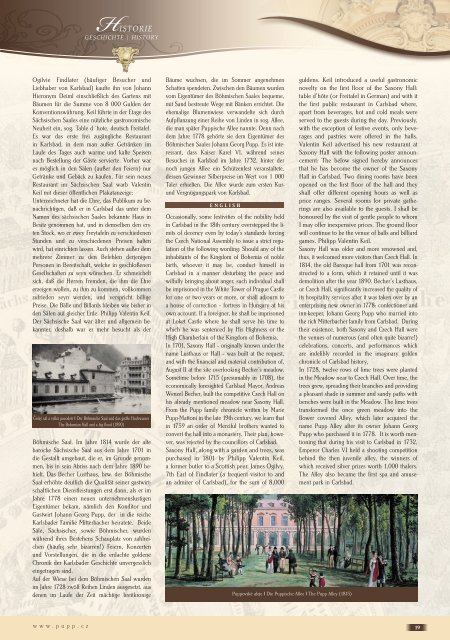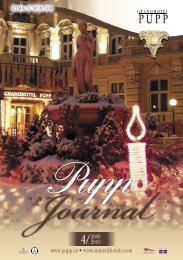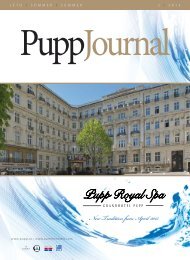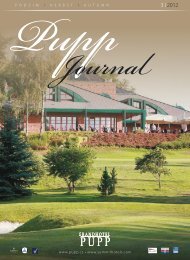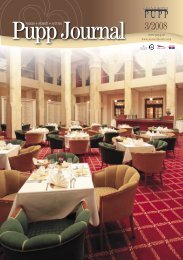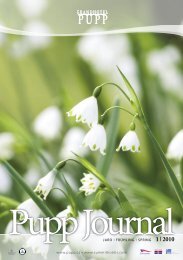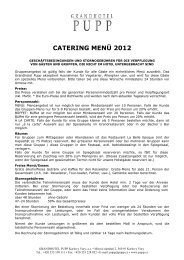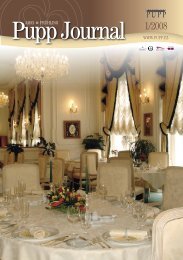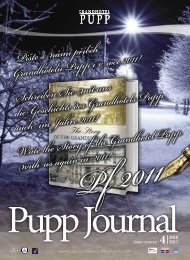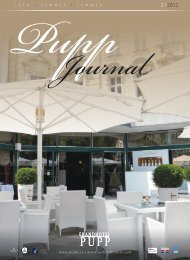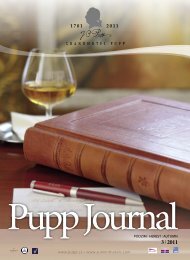Pupp Journal Léto 2009 - Grandhotel Pupp
Pupp Journal Léto 2009 - Grandhotel Pupp
Pupp Journal Léto 2009 - Grandhotel Pupp
Sie wollen auch ein ePaper? Erhöhen Sie die Reichweite Ihrer Titel.
YUMPU macht aus Druck-PDFs automatisch weboptimierte ePaper, die Google liebt.
HISTORIE<br />
GESCHICHTE | HISTORY<br />
Ogilvie Findlater (häufiger Besucher und<br />
Liebhaber von Karlsbad) kaufte ihn von Johann<br />
Hieronym Deiml einschließlich des Gartens mit<br />
Bäumen für die Summe von 8 000 Gulden der<br />
Konventionswährung. Keil führte in der Etage des<br />
Sächsischen Saales eine nützliche gastronomische<br />
Neuheit ein, sog. Table d´hote, deutsch Freitafel.<br />
Es war das erste frei zugängliche Restaurant<br />
in Karlsbad, in dem man außer Getränken im<br />
Laufe des Tages auch warme und kalte Speisen<br />
nach Bestellung der Gäste servierte. Vorher war<br />
es möglich in den Sälen (außer den Feiern) nur<br />
Getränke und Gebäck zu kaufen. Für sein neues<br />
Restaurant im Sächsischen Saal warb Valentin<br />
Keil mit dieser öffentlichen Plakatanzeige:<br />
Unterzeichneter hat die Ehre, das Publikum zu benachrichtigen,<br />
daß er in Carlsbad das unter dem<br />
Namen des sächsischen Saales bekannte Haus in<br />
Besitz genommen hat, und in demselben den ersten<br />
Stock, wo er zwey Freytafeln zu verschiedenen<br />
Stunden und zu verschiedenen Preisen halten<br />
wird, hat einrichten lassen. Auch stehen außer dem<br />
mehrere Zimmer zu den Befehlen derjenigen<br />
Personen in Bereitschaft, welche in geschloßenen<br />
Gesellschaften zu seyn wünschen. Er schmeichelt<br />
sich, daß die Herren Fremden, die ihm die Ehre<br />
erzeigen wollen, zu ihm zu kommen, vollkommen<br />
zufrieden seyn werden, und verspricht billige<br />
Preise. Die Bälle und Billards bleiben wie bisher in<br />
den Sälen auf gleicher Erde. Philipp Valentin Keil.<br />
Der Sächsische Saal war älter und allgemein bekannter,<br />
deshalb war er mehr besucht als der<br />
Český sál a velká povodeň I Der Böhmische Saal und das große Hochwasser<br />
The Bohemian Hall and a big flood (1890)<br />
Böhmische Saal. Im Jahre 1814 wurde der alte<br />
barocke Sächsische Saal aus dem Jahre 1701 in<br />
die Gestallt umgebaut, die er, im Grunde genommen,<br />
bis in sein Abriss nach dem Jahre 1890 behielt.<br />
Das Becher Lusthaus, bzw. der Böhmische<br />
Saal erhöhte deutlich die Qualität seiner gastwirtschaftlichen<br />
Dienstleistungen erst dann, als er im<br />
Jahre 1778 einen neuen unternehmenslustigen<br />
Eigentümer bekam, nämlich den Konditor und<br />
Gastwirt Johann Georg <strong>Pupp</strong>, der in die reiche<br />
Karlsbader Familie Mitterbacher heiratete. Beide<br />
Säle, Sächsischer, sowie Böhmischer, wurden<br />
während ihres Bestehens Schauplatz von zahlreichen<br />
(häufig sehr bizarren!) Feiern, Konzerten<br />
und Vorstellungen, die in die erdachte goldene<br />
Chronik der Karlsbader Geschichte unvergesslich<br />
eingetragen sind.<br />
Auf der Wiese bei dem Böhmischen Saal wurden<br />
im Jahre 1728 zwölf Reihen Linden ausgesetzt, aus<br />
denen im Laufe der Zeit mächtige breitkronige<br />
Bäume wuchsen, die im Sommer angenehmen<br />
Schatten spendeten. Zwischen den Bäumen wurden<br />
vom Eigentümer des Böhmischen Saales bequeme,<br />
mit Sand bestreute Wege mit Bänken errichtet. Die<br />
ehemalige Blumenwiese verwandelte sich durch<br />
Aufpflanzung einer Reihe von Linden in sog. Allee,<br />
die man später <strong>Pupp</strong>ische Allee nannte. Denn nach<br />
dem Jahre 1778 gehörte sie dem Eigentümer des<br />
Böhmischen Saales Johann Georg <strong>Pupp</strong>. Es ist interessant,<br />
dass Kaiser Karel VI. während seines<br />
Besuches in Karlsbad im Jahre 1732, hinter der<br />
noch jungen Allee ein Schützenfest veranstaltete,<br />
dessen Gewinner Silberpreise im Wert von 1 000<br />
Taler erhielten. Die Allee wurde zum ersten Kurund<br />
Vergnügungspark von Karlsbad.<br />
ENGLISH<br />
Occasionally, some festivities of the nobility held<br />
in Carlsbad in the 18th century overstepped the limits<br />
of decency even by today’s standards forcing<br />
the Czech National Assembly to issue a strict regulation<br />
of the following wording: Should any of the<br />
inhabitants of the Kingdom of Bohemia of noble<br />
birth, whoever it may be, conduct himself in<br />
Carlsbad in a manner disturbing the peace and<br />
wilfully bringing about anger, such individual shall<br />
be imprisoned in the White Tower of Prague Castle<br />
for one or two years or more, or shall adjourn to<br />
a house of correction – fortress in Hungary at his<br />
own account. If a foreigner, he shall be imprisoned<br />
at Loket Castle where he shall serve his time to<br />
which he was sentenced by His Highness or the<br />
High Chamberlain of the Kingdom of Bohemia.<br />
In 1701, Saxony Hall – originally known under the<br />
name Lusthaus or Hall – was built at the request,<br />
and with the financial and material contribution of,<br />
August II at the site overlooking Becher’s meadow.<br />
Sometime before 1715 (presumably in 1708), the<br />
economically foresighted Carlsbad Mayor, Andreas<br />
Wenzel Becher, built the competitive Czech Hall on<br />
his already mentioned meadow near Saxony Hall.<br />
From the <strong>Pupp</strong> family chronicle written by Marie<br />
<strong>Pupp</strong>-Mattoni in the late 19th century, we learn that<br />
in 1759 an order of Merciful brothers wanted to<br />
convert the hall into a monastery. Their plan, however,<br />
was rejected by the councillors of Carlsbad.<br />
Saxony Hall, along with a garden and trees, was<br />
purchased in 1801 by Philipp Valentin Keil,<br />
a former butler to a Scottish peer, James Ogilvy,<br />
7th Earl of Findlater (a frequent visitor to and<br />
an admirer of Carlsbad), for the sum of 8,000<br />
<strong>Pupp</strong>ovské aleje I Die <strong>Pupp</strong>ische Allee I The <strong>Pupp</strong> Alley (1815)<br />
guldens. Keil introduced a useful gastronomic<br />
novelty on the first floor of the Saxony Hall:<br />
table d’hôte (or Freitafel in German) and with it<br />
the first public restaurant in Carlsbad where,<br />
apart from beverages, hot and cold meals were<br />
served to the guests during the day. Previously,<br />
with the exception of festive events, only beverages<br />
and pastries were offered in the halls.<br />
Valentin Keil advertised his new restaurant at<br />
Saxony Hall with the following poster announcement:<br />
The below signed hereby announces<br />
that he has become the owner of the Saxony<br />
Hall in Carlsbad. Two dining rooms have been<br />
opened on the first floor of the hall and they<br />
shall offer different opening hours as well as<br />
price ranges. Several rooms for private gatherings<br />
are also available to the guests. I shall be<br />
honoured by the visit of gentle people to whom<br />
I may offer inexpensive prices. The ground floor<br />
will continue to be the venue of balls and billiard<br />
games. Philipp Valentin Keil.<br />
Saxony Hall was older and more renowned and,<br />
thus, it welcomed more visitors than Czech Hall. In<br />
1814, the old Baroque hall from 1701 was reconstructed<br />
to a form, which it retained until it was<br />
demolition after the year 1890. Becher’s Lusthaus,<br />
or Czech Hall, significantly increased the quality of<br />
its hospitality services after it was taken over by an<br />
enterprising new owner in 1778: confectioner and<br />
inn-keeper, Johann Georg <strong>Pupp</strong> who married into<br />
the rich Mitterbacher family from Carlsbad. During<br />
their existence, both Saxony and Czech Hall were<br />
the venues of numerous (and often quite bizarre!)<br />
celebrations, concerts, and performances which<br />
are indelibly recorded in the imaginary golden<br />
chronicle of Carlsbad history,<br />
In 1728, twelve rows of lime trees were planted<br />
in the Meadow near to Czech Hall. Over time, the<br />
trees grew, spreading their branches and providing<br />
a pleasant shade in summer and sandy paths with<br />
benches were built in the Meadow. The lime trees<br />
transformed the once green meadow into the<br />
flower covered Alley, which later acquired the<br />
name <strong>Pupp</strong> Alley after its owner Johann Georg<br />
<strong>Pupp</strong> who purchased it in 1778. It is worth mentioning<br />
that during his visit to Carlsbad in 1732,<br />
Emperor Charles VI held a shooting competition<br />
behind the then juvenile alley, the winners of<br />
which received silver prizes worth 1,000 thalers.<br />
The Alley also became the first spa and amusement<br />
park in Carlsbad.<br />
www.pupp.cz 19


